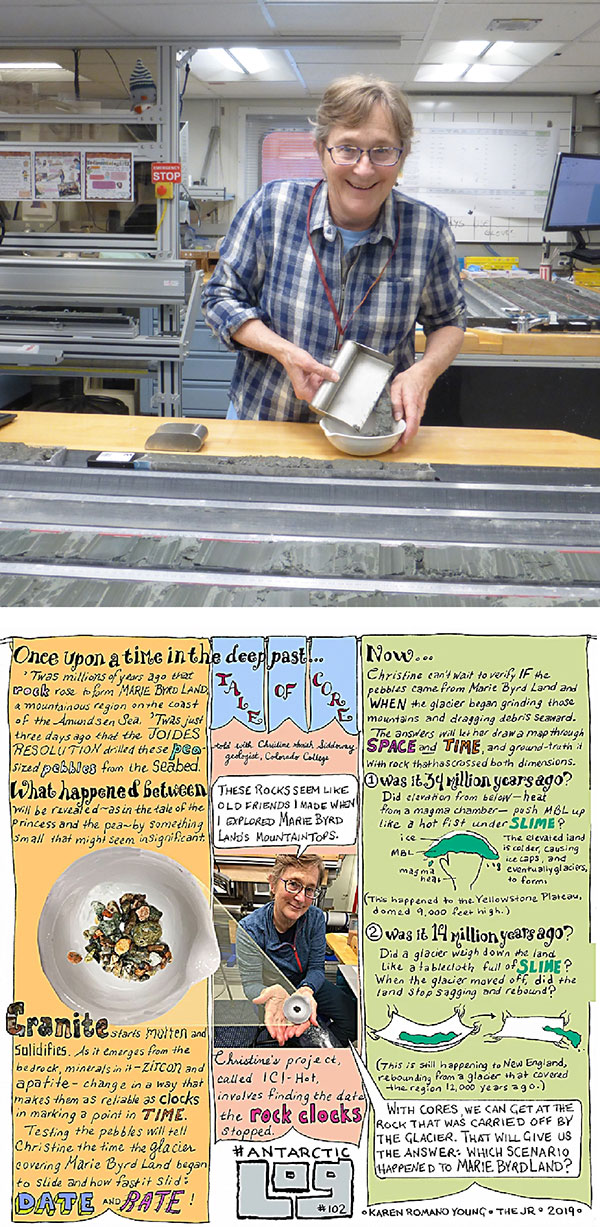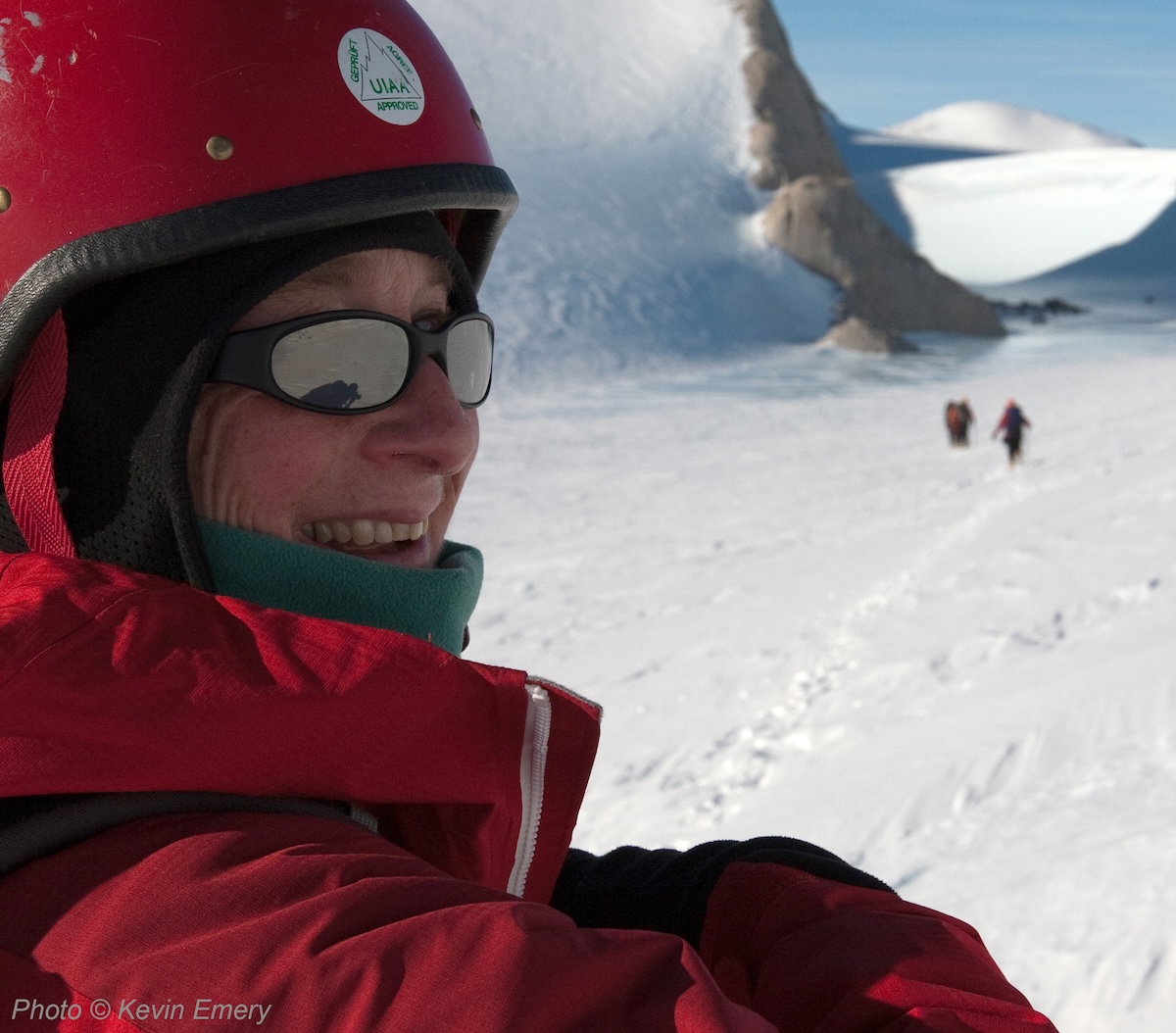Colorado College Professor of Geology Christine Siddoway has been awarded a $199,793 grant from the National Science Foundation. CC is the lead institution on this grant, which also supports her collaborators at the University of Arizona and University of Minnesota with $307,640 in additional funding.
The funds support work on project ICI-Hot, which investigates the time of formation of the West Antarctic ice sheet and will extend knowledge of the geological makeup of subglacial bedrock concealed by the ice. "If we are successful in establishing the chronology for this pivotal event in the deep past, which has bearing on the past tens of millions of years of Earth's climate, we will advance new methods that will enhance our ability to forecast ice sheet changes in the future," Siddoway says of the research.
The new award arrives at a culminating moment for another one of Siddoway's projects, ROSETTA-Ice, part of NSF's Antarctic Integrated System Science program. ROSETTA-Ice is a three-year, multi-institutional data acquisition in Antarctica that has assembled an unprecedented view of the Ross Ice Shelf, its structure, and how it has been changing over time. Siddoway co-authored the study, "Ross Ice Shelf response to climate driven by the tectonic imprint on seafloor bathymetry," published in 2019 by Nature Geoscience.
Siddoway, who has made 14 trips to Antarctica, studies the geological evolution of Antarctica and the Colorado Front Range using approaches from structural geology and petrology. She includes material from her current Antarctic research in the teaching of both thematic and topical courses, such as the recent First Year Experience course In Extinction's Embrace: Geological Perspectives on Popular Climate Nonfiction. Her funded research project always include investigation opportunities for CC undergraduates.
The 2019 Nature Geoscience article reports the discovery of an ancient bedrock structure beneath the midline of the Ross Ice Shelf, which influences where a vulnerable part of Antarctica's icesheet melts and where it stays firm and frozen. The structure, an old tectonic boundary, focuses the flow of ocean currents beneath a vast expanse of the ice sheet that is afloat upon ocean water. The finding raises the possibility that local ocean currents may play a crucial role in the Ross Ice Shelf's ultimate retreat, says Siddoway.
The ROSETTA-Ice team collected data from the massive Ross Ice Shelf, a region of floating icesheet that is the size of Spain. The shelf is well anchored around its perimeter, which helps it to slow the flow of about 20 percent of Antarctica's grounded ice into the ocean - equivalent to 38 feet of global sea level rise. The team faced the challenge of how to gather bedrock data for the vast shelf, since its ice is frequently more than a thousand feet thick prevents access by more traditional ship-based surveys of the seabed.
![AlecLockett_ROSETTAIce[2]](/newsevents/newsroom/images/AlecLockett_ROSETTAIce[2].jpg)
Alec Lockett '17 (on right) monitoring readings from the magnetometer during an airborne survey for ROSETTA-Ice.
The survey solution was IcePod, a first-of-its kind multi-instrument system designed to collect high-resolution data across the polar regions. Developed at Columbia University's Lamont-Doherty Earth Observatory, Icepod was mounted on a U.S. National Guard LC130 cargo plane that is ski-equipped for landings on the ice in Antarctica. Its instruments measured ice shelf height, thickness and internal structure, and the magnetic and gravity signals from the underlying rock. CC graduate Alec Lockett '17 had responsibility for magnetic measurements aboard the LC130, during night flights over two of the three seasons of the airborne survey. With these data, the ROSETTA-Ice researchers reconstructed maps of the top and bottom of the ice shelf and of the first-ever seabed bathymetry.
In the rock's magnetic data, the newly identified tectonic boundary stands out prominently. This bedrock feature that bisects the Ross Ice Shelf matters because it helps shape the seabed floor and influences the manner and location of flow of ocean water beneath the shelf. This boundary protects the ice shelf's grounding line, the point at which it is thick enough to extend all the way to the sea floor. The geology created by the boundary keeps warm, melt-promoting ocean water away from that part of the shelf. But the ocean circulation driven by that same geology drives intense summer melt along the shelf's easterly edge.
"We could see that the geological boundary was making the seafloor on the east Antarctic side much deeper than the west, and that allows ocean water to circulate under the ice shelf, weakening the ice above" said study leader Kirsty Tinto, a research scientist at Lamont-Doherty Earth Observatory at Columbia University.
Siddoway says, "A role for Colorado College students in the ROSETTA-Ice Project was planned into the National Science Foundation grant from the outset. The first to use the high resolution ice radar data sets, Gina Jozef '18 and Skye Keeshin '18 mapped internal features of the ice sheet and identified sites of melting from below. Matt Tankersley '18 used magnetics and gravity data to rigorously test and verify the tectonic boundary interpretation. They are able to leverage these experiences as they secure graduate research positions in top university programs, aiming to continue with polar research.
"The skills and motivation for this endeavor are much-needed, at present, because changes at the Poles are of direct consequence for society," says Siddoway. "Antarctica's ice is melting at an accelerating rate. As the planet continues to warm, it is ever more critical to predict how its ice sheets will respond." This requires an understanding of the complex ways in which the ice, ocean, atmosphere, and geology interact with each other. "Therefore, the data acquisition and our initial publication are only the beginning for ROSETTA-Ice research," says Siddoway. "Now that the ten or more data types have been acquired, its 'all hands on deck!' to put them to use for primary exploration of this vast region of Antarctica that has never before been seen in this detail." Current CC students Sarah Packard '22 and Jonny Norwine '22 are working as polar geophysics interns at LDEO this summer, supported by CC's Witter Family Fund. "The Witter internships allow these two second-year students to be trained in use of specialized software and instrumentation that are not available at CC, and to gain practical experience with radar and geophysical datasets that are commonly used in industry, academics, and space exploration," says Siddoway. "Who knows? They may in the future apply their new skills to similar datasets obtained for the moon, or Mars - planetary bodies whose geology also needs to be determined using indirect means."
In addition to Siddoway from Colorado College, the ROSETTA-Ice project partners include Lamont-Doherty Earth Observatory of Columbia University, Scripps Institution of Oceanography at the University of California San Diego, Earth and Space Research and GNS Science, New Zealand. Fieldwork was supported by the United States Antarctic Program and the New York Air National Guard, the New Zealand Ministry of Business Innovation and Employment, and the New Zealand Antarctic Research Institute. ROSETTA-Ice is funded by the National Science Foundation, The Moore Foundation, and the Old York Foundation.
In addition to Rosetta-Ice research, Siddoway is active in the International Ocean Discovery Program, following her participation in Expedition 379, Amundsen Sea West Antarctic Ice Sheet History, early in 2019.
The newly awarded NSF grants support her use of offshore sediment records to determine the cycles of waxing and waning of the West Antarctic ice sheet, over time. The sediment cores were obtained by drilling the deep seabed of the Southern Ocean during IODP379. Her other project, ICI-Hot, investigates the geological and geographic conditions for onset of glaciation, millions of years ago, and the origins of the West Antarctic ice sheet. These results will refine ice sheet history and aid the international societal response to contemporary ice sheet change and its global consequences. A central component of the project is the training of two undergraduate and two graduate students from five institutions, who will function as a scientific cohort engaged in Antarctic climate research and public outreach.

[upper]: Siddoway with split cores of sediment drilled from the Amundsen Sea bed, in water depths > 2.5 miles. [lower]: A feature on the ICI-Hot project from AntarcticLOG 2019 , by artist Karen Romano Young, who sailed on IODP379.







